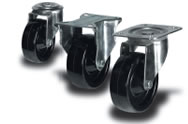
Castors Dublin makes moving machinery, furniture, and other bulky or heavy items simple. They enable rolling and consist of a wheel fastened to a plate or assembly. Providing it has Castors, you can roll an object to move it instead of lifting it. Even though you might be familiar with casters in general, there are certain things you don't know about them.
A Dublin castor is a type of wheel that is not motorized and is used to move larger objects by being attached to the bottom. Device moving equipment has Castor wheels attached to the base that enable movement of certain things. With minimal effort, they make it possible to move large items. Frequent maintenance is necessary for caster wheels to function more effectively over time.
Castors Industrial
Today, many industrial Castor bodies are created by the first laser cutting the body from a single metal blank, then using a press brake to bend the legs to the necessary ninety-degree angle, creating a more robust device.
Many aspects impact the performance of Castor Industrial. For instance, larger wheel diameters and widths offer increased weight capability by dispersing the load's weight over a wider tire surface area. Additionally, stricter wheel materials—such as cast iron and high-profile polyurethane—are less susceptible and tend not to track dirt and other debris onto floors.
Compound logic gates, also known as Complex logic gates, are low-tech electronic components that perform similarly to several basic logic gates. These gates, which are frequently constructed from a few layers of logic, can be utilized to optimize different circuits in terms of space and transistors, leading to higher performance.
It is particularly true when development is limited to the default cell library of a vendor. While genuine logic designers rarely utilize some gates, optimization programs frequently employ them since they can use them effectively.
